Tiverton, Devon
Up to 1834
In 1698, following the example of Bristol two years before, Tiverton successfully promoted a private Act of Parliament (9 William III, c.18) for the "erection of ... hospitals and workhouses for better employment and maintenance of the poor." Paupers were accommodated in a "hospital" erected in 1704.
Parish workhouses were also in operation at Bampton from around 1732, at Cullompton and at Cruwys Morchard from 1738, and at Uffculme from 1750 (Hitchcock, 1985).
A property known as the Old Malthouse on the south side of Briton Street in Bampton is said to have housed the local workhouse. From 1932 to 1971, with a break during the Second World War, the premises served as a a youth hostel. It has now been divided into two houses.
Silverton's parish workhouse, with an adjacent row of almshouses and a house of correction, stood at the west side of the High Street just north of the Lamb Inn. The almshouses were known as "Cotton's Row" and were rebuilt on at least two occasions following damage by fire.
A parliamentary report of 1777 recorded parish workhouses in operation at Tiverton (for up to 400 inmates), Bampton (60), Cadbury (10), Collumpton (120), Huntsham (Two families), Loxbear (6), Silverton (60), and Uffculme (50). The capacity of the Tiverton workhouse made it one of the largest in England at that time.
Eden, in his 1797 survey of the poor in England, reported of Tiverton that:
After 1834
Tiverton Poor Law Union formally came into existence on 30th November 1835. Its operation was overseen by an elected Board of Guardians, 39 in number, representing its 28 constituent parishes as listed below (figures in brackets indicate numbers of Guardians if more than one):
Devon: Bampton (2), Bradninch (2), Bickleigh, Butterleigh, Cadbury, Cadleigh, Calverleigh, Clarghanger, Cullompton (3), Cruwys Morchard, Halberton (2), Hockworthy, Holcombe Regis, Huntsham, Kentisbear, Loxbear, Morebath, Oakford, Sampford, Silverton (2), Stoodley, Templeton, Thorverton (2), Tiverton (4), Uffculm (2), Uplowman, Washfield, Willand.
Later addition: Highley St Mary (1858-94).
The population falling within the Union at the 1831 census had been 32,144 with parishes ranging in size from Calverleigh (population 91) to Tiverton itself (9,766). The average annual poor-rate expenditure for the period 1833-35 had been £18,626 or 11s.7d. per head of the population.
A new union workhouse was built in 1837-8 on the site of the old town workhouse on the south side of Belmont Road in Tiverton. It was designed by George Gilbert Scott and his partner William Bonython Moffatt who were also the architects for other Devon workhouses in Bideford, Newton Abbot, and Tavistock. Intended to accommodate 300 inmates, the Poor Law Commissioners authorised the sum of £6,000 on its construction. The workhouse location and layout are shown on the 1903 map below.
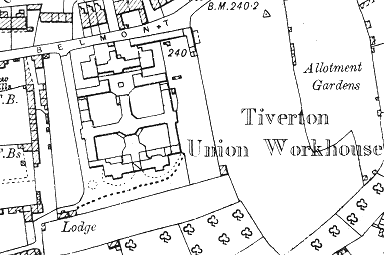
Tiverton site, 1903.
The workhouse had a porter's lodge at the south-west of the site.
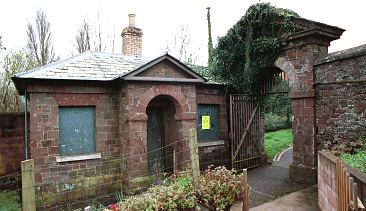
Tiverton porter's lodge from the north.
© Peter Higginbotham.
The main workhouse followed Scott and Moffatt's typical design. It had a single-storey front block with a central entrance archway. Only the western entrance block survives.

Tiverton workhouse from the south, 2001.
© Peter Higginbotham.
To its rear was the main accommodation block at the centre of which was located the master's quarters, with accommodation for males to one side, and females at the other.
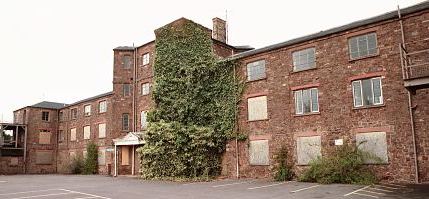
Tiverton main block from the south-east, 2001.
© Peter Higginbotham.
The workhouse kitchen was at the centre rear of the main block.
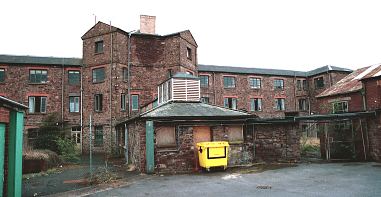
Tiverton main block and kitchen from the north, 2001.
© Peter Higginbotham.
At the north of the site, backing on to the main road, stood the workhouse infirmary.
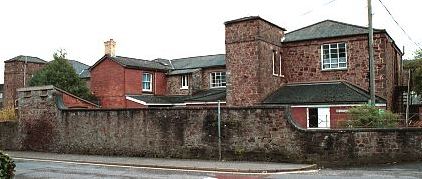
Tiverton infirmary block from the north-west, 2001.
© Peter Higginbotham.
The workhouse site later became Belmont Hospital which has now closed. At the time of writing, the site is awaiting redevelopment.
Shillingford and Ayshford Children's Homes
The Tiverton union operated a children's home at Shillingford in the parish of Bampton, then another at Ayshford. The following information on the homes was very kindly provided by staff at the Devon Record Office.
It is probable that the Shillingford home opened not long before June 30th, 1913, as on that date, ten children from the home were admitted to the nearby Shillingford and Petton Primary School, and another eight were admitted in July of the same year. Although no union minutes survive from this date, the admission register and log book for the school allow the early history of the home and the names of some of its occupants to be reconstructed.
All the children except the youngest who were admitted in 1913 had previously attended Elmore School in Tiverton. This appears to have been the school which children living at the workhouse in Tiverton normally attended, before Shillingford Home was opened. Thus, children of school age who lived in Tiverton workhouse in the early 20th century can be identified from the Elmore School admission registers.
The guardian of the children admitted to Shillingford and Petton School was E. Knight, who presumably ran the Shillingford Home. Other children were admitted as they reached school age, and thus the names of all of the children at the Home who were of school age while it remained open can be identified in the admission register. The school log book, kept by the headteacher, contains entries recording the admission of the ten children from the home on 30th June 1913 and the admission of seven girls and one boy on 21st July 1913, but their names are not mentioned. The inspector for religious instruction visited the school on 29th September 1913 and in his report he wrote that 'The attendance has been much increased by the presence of children from a "home" established in the village by the Guardians of the Tiverton Union. It was a pleasure to see these children so thoroughly happy. Although they had been but a short time at the school they entered with spirit & interest into the work & answered, as a rule, with much intelligence.'
In 1920, the surviving minutes of the Tiverton Poor Law Union Guardians begin, and contain regular reports from the children's home, although it was never stated where the home was and the children living there were not mentioned by name. In 1922 and 1923, the Guardians were occupied with buying Ayshford Home in Uffculme and making it ready for use as a new children's home.
There was no minute to state that the children's home had moved, but at the meeting on 30th October 1923, there was a minute stating that it was 'Resolved that not more than two inmates of the Workhouse who are relatives of children at the Ayshford Home, be allowed to visit their children in each month.'
On 31st October 1923, the school log book noted that 'Owing to the closure of the Shillingford Children's Home, 26 children will be leaving this school this afternoon to attend the Uffculme school.'
Staff
Inmates
Records
Note: many repositories impose a closure period of up to 100 years for records identifying individuals. Before travelling a long distance, always check that the records you want to consult will be available.
- Devon Heritage Centre, Great Moor House, Bittern Road, Sowton Exeter EX2 7NL. Relatively few local records survive. Holdings include: Admissions registers (1767-1776); Guardians' minute books (1920-36); Staff register (1831-1921).
Bibliography
- Hitchcock, T.V. (1985) The English workhouse: a study in institutional poor relief in selected counties. l695-l750. (DPhil thesis. University of Oxford.)
Links
- None.
Unless otherwise indicated, this page () is copyright Peter Higginbotham. Contents may not be reproduced without permission.


